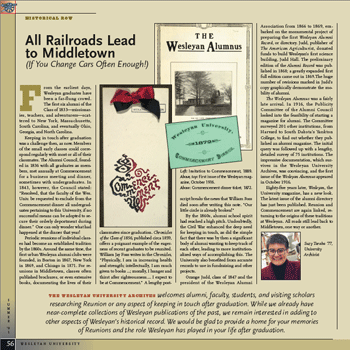HISTORICAL ROW: ALL RAILROADS LEAD TO MIDDLETOWN
 From the earliest days, Wesleyan graduates have been a far-flung crowd. The first six alumni of the Class of 1833—missionaries, teachers, and adventurers—scattered to New York, Massachusetts, South Carolina, and eventually Ohio, Georgia, and North Carolina.
From the earliest days, Wesleyan graduates have been a far-flung crowd. The first six alumni of the Class of 1833—missionaries, teachers, and adventurers—scattered to New York, Massachusetts, South Carolina, and eventually Ohio, Georgia, and North Carolina.
Keeping in touch after graduation was a challenge then, as now. Members of the small early classes could correspond regularly with most or all of their classmates. The Alumni Council, founded in 1836 with all graduates as members, met annually at Commencement for a business meeting and dinner, sometimes with undergraduates. In 1843, however, the Council stated: “Resolved, that the faculty of the Wes. Univ. be requested to exclude from the Commencement dinner all undergraduates pertaining to this University, if no successful means can be adopted to secure their orderly deportment during dinner.” One can only wonder what had happened at the dinner that year!
Periodic reunions of individual classes had become an established tradition by the 1860s. Around the same time, the first urban Wesleyan alumni clubs were founded, in Boston in 1867, New York in 1869, and Chicago in 1871. For reunions in Middletown, classes often published brochures, or even extensive books, documenting the lives of their classmates since graduation. Chronicles of the Class of 1856, published circa 1859, offers a poignant example of the eagerness of recent graduates to be reunited. William Jay Foss writes in the Chronicles, “Physically, I am in increasing health and strength; intellectually, I am much given to books …; morally, I hunger and thirst after righteousness. … I expect to be at Commencement.” A lengthy postscript breaks the news that William Foss died soon after writing this note. “Our little circle is already broken!”
By the 1860s, alumni school spirit had reached a high pitch. Undoubtedly, the Civil War enhanced the deep need for keeping in touch, as did the simple fact that there was by then a significant body of alumni wanting to keep track of each other, leading to more institutionalized ways of accomplishing this. The University also benefited from accurate records to use in fundraising and other projects.
Orange Judd, class of 1847 and the president of the Wesleyan Alumni Association from 1866 to 1869, embarked on the monumental project of preparing the first Wesleyan Alumni Record, or directory. Judd, publisher of The American Agriculturist, donated funds to build Wesleyan’s first science building, Judd Hall. The preliminary edition of the Alumni Record was published in 1868; a greatly expanded first full edition came out in 1869. The huge number of revisions marked in Judd’s copy graphically demonstrate the mobility of alumni.
The Wesleyan Alumnus was a fairly late arrival. In 1916, the Publicity Committee of the Alumni Council looked into the feasibility of starting a magazine for alumni. The Committee surveyed 201 other institutions, from Harvard to South Dakota’s Yankton College, to find out whether they published an alumni magazine. The initial query was followed up with a lengthy, detailed survey of 75 institutions. The impressive documentation, which survives in the Wesleyan University Archives, was convincing, and the first issue of the Wesleyan Alumnus appeared in October 1916.
Eighty-five years later, Wesleyan, the University magazine, has a new look. The latest issue of the alumni directory has just been published. Reunion and Commencement are again linked, returning to the origins of these traditions at Wesleyan. All roads still lead back to Middletown, one way or another.
—Suzy Taraba ’77
University Archivist
